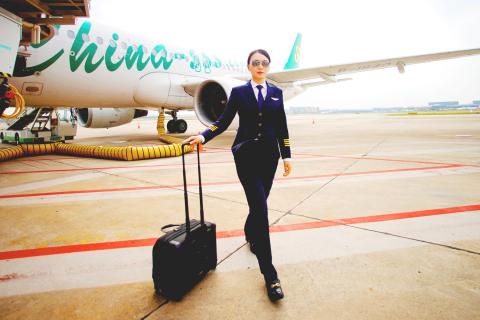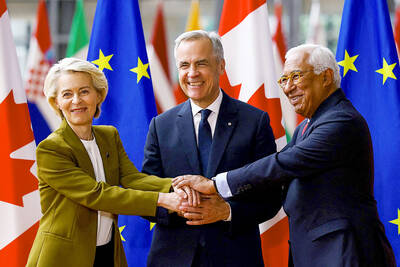When Han Siyuan (韓思圓) first decided to apply for a job as a pilot cadet in 2008, she was up against 400 female classmates in China on tests measuring everything from their command of English to the length of their legs.
Eventually, she became the only woman from her university that Shanghai-based Spring Airlines picked for training that year.
She is now a captain for the Chinese budget carrier, but it has not become much easier for the women who have come after her.

Photo: Reuters
Han is one of just 713 women in China who, at the end of last year, held a license to fly civilian aircraft, compared with 55,052 men.
Of Spring Airlines’ 800 pilots, only six are women.
“I’ve gotten used to living in a man’s world,” Han said.
China’s proportion of female pilots — at 1.3 percent — is one of the world’s lowest, which analysts and pilots attribute to social perceptions and male-centric hiring practices by Chinese airlines, but Chinese airlines are struggling with an acute pilot shortage amid surging travel demand and female pilots are drawing attention to the gender imbalance.
Chinese carriers need 128,000 new pilots over the next two decades, according to forecasts by plane maker Boeing Co, and the shortfall has so far prompted airlines to aggressively hire foreign captains and Chinese regulators to relax physical entry requirements for cadets.
“The mission is to start cutting down the thorns that cover this road, to make it easier for those who come after us,” said Chen Jingxian (陳靜嫻), a Shanghai-based lawyer who learned to fly in the US and is among those urging change.
Such issues are not confined to China; the proportion of female pilots in South Korea and Japan, where such jobs do not conform to widespread gender stereotypes, is also less than 3 percent.
However, it is a sharp contrast to the situation in India, which, like China, has a fast-growing aviation market, but thanks to aggressive recruiting and support such as day care, India has the world’s highest proportion of female commercial pilots, at 12 percent.
China’s airlines only hire cadets directly from universities or the military. They often limit recruitment drives to male applicants and very rarely take in female cohorts.
Li Haipeng (李海鵬), deputy director of the Civil Aviation Management Institute of China’s General Aviation Department, said many airlines were also dissuaded to hire women by generous maternity leave policies.
That has been further aggravated by Beijing’s move in 2015 to change the one-child policy, he added.
“Male pilots do not have the issue of not being able to fly for two years after giving birth and after the introduction of the second-child policy, airlines are not willing to recruit and train a pilot only to have her not being able to fly for about five years,” Li said.
The strongest calls for change are coming mostly from Chinese female pilots, thanks to a slew of returnees who learned how to fly while living abroad in nations such as the US.
In March, the China Airline Pilots Association established a female branch at an event attended by pilots from the People’s Liberation Army Air Force and local airlines, according to media reports.
Chen, who also serves as a vice president of the association’s women’s branch, said she and others have been trying to spread the word by speaking about the issue at air shows in China.
Eventually the organization hopes to persuade Chinese airlines to adjust their recruitment and maternity policies, she said.
Another key obstacle to tackle, she added, was the inability of general aviation pilots to shift to the commercial sector.
“It’s a systemic issue,” she said. “We hope that change can happen in three to five years, but this is not something that is up to us.”
Others like Han, who in recent months has appeared in Spring Airlines promotional videos, said she hoped the growing publicity would help to raise awareness.
“I can’t personally give people opportunities, but I hope that [the publicity] can slowly help open the door for companies or for girls with dreams to fly,” she said.

The team behind the long-awaited Vera Rubin Observatory in Chile yesterday published their first images, revealing breathtaking views of star-forming regions as well as distant galaxies. More than two decades in the making, the giant US-funded telescope sits perched at the summit of Cerro Pachon in central Chile, where dark skies and dry air provide ideal conditions for observing the cosmos. One of the debut images is a composite of 678 exposures taken over just seven hours, capturing the Trifid Nebula and the Lagoon Nebula — both several thousand light-years from Earth — glowing in vivid pinks against orange-red backdrops. The new image

Canada and the EU on Monday signed a defense and security pact as the transatlantic partners seek to better confront Russia, with worries over Washington’s reliability under US President Donald Trump. The deal was announced after a summit in Brussels between Canadian Prime Minister Mark Carney and European Commission President Ursula von der Leyen and European Council President Antonio Costa. “While NATO remains the cornerstone of our collective defense, this partnership will allow us to strengthen our preparedness ... to invest more and to invest smarter,” Costa told a news conference. “It opens new opportunities for companies on both sides of the

ESPIONAGE: The British government’s decision on the proposed embassy hinges on the security of underground data cables, a former diplomat has said A US intervention over China’s proposed new embassy in London has thrown a potential resolution “up in the air,” campaigners have said, amid concerns over the site’s proximity to a sensitive hub of critical communication cables. The furor over a new “super-embassy” on the edge of London’s financial district was reignited last week when the White House said it was “deeply concerned” over potential Chinese access to “the sensitive communications of one of our closest allies.” The Dutch parliament has also raised concerns about Beijing’s ideal location of Royal Mint Court, on the edge of the City of London, which has so

OVERHAUL: The move would likely mark the end to Voice of America, which was founded in 1942 to counter Nazi propaganda and operated in nearly 50 languages The parent agency of Voice of America (VOA) on Friday said it had issued termination notices to more than 639 more staff, completing an 85 percent decrease in personnel since March and effectively spelling the end of a broadcasting network founded to counter Nazi propaganda. US Agency for Global Media (USAGM) senior advisor Kari Lake said the staff reduction meant 1,400 positions had been eliminated as part of US President Donald Trump’s agenda to cut staffing at the agency to a statutory minimum. “Reduction in Force Termination Notices were sent to 639 employees at USAGM and Voice of America, part of a